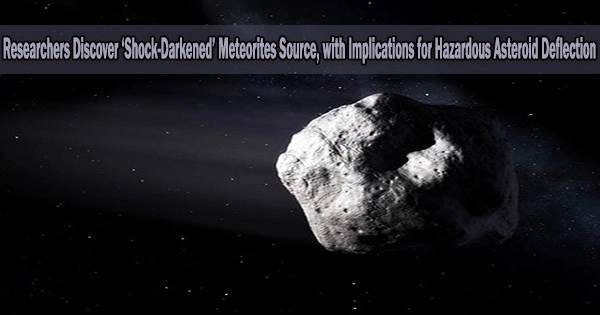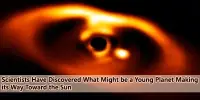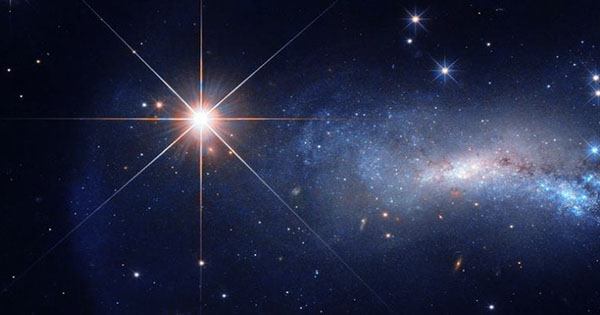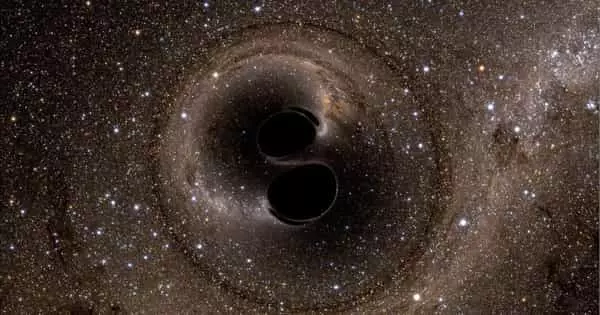Shock-darkened meteorites are meteorites that have undergone shock metamorphism, a type of metamorphism that occurs when a meteorite experiences a sudden and intense increase in pressure. This can happen when the meteorite is subjected to the shock waves generated by an impact with the surface of a planet or other celestial body.
During the 2013 Chelyabinsk fireball explosion over Russian skies, a rather rare sort of meteorite fell to Earth. The black veins, which are a result of a process known as shock darkening, are what distinguish the Chelyabinsk meteorites from others of a similar type. However, until today, planetary scientists were unable to identify a local asteroid source of these particular meteorites.
Researchers from the University of Arizona identified an asteroid known as 1998 OR2 as one probable source of shock-darkened meteorites in a recent research that was published in the Planetary Science Journal. About 1 1/2 miles wide, the near-Earth asteroid passed by Earth in close proximity in April 2020. Asteroids that fragment into space and then crash to Earth are referred to as meteorites.
“Shock darkening is an alteration process caused when something impacts a planetary body hard enough that the temperatures partially or fully melt those rocks and alter their appearance both to the human eye and in our data,” said lead study author Adam Battle, a UArizona graduate student studying planetary science. “This process has been seen in meteorites many times but has only been seen on asteroids in one or two cases way out in the main asteroid belt, which is found between Mars and Jupiter.”
Battle’s mentor and study co-author Vishnu Reddy,a planetary sciences professor, found shock darkening on main belt asteroids in 2013 and 2014. Together with engineering professor Roberto Furfaro, Reddy co-directs the Lunar and Planetary Laboratory’s Space Domain Awareness lab. Battle has worked in the lab since 2019.
“Impacts are very common in asteroids and any solid body in the solar system because we see impact craters on these objects from spacecraft images. But impact melt and shock-darkening effects on meteorites derived from these bodies are rare. Finding a near-Earth asteroid dominated by this process has implications for impact hazard assessment,” Reddy said. “Adam’s work has shown that ordinary chondrite asteroids can appear as carbonaceous in our classification tools if they are affected by shock darkening. These two materials have different physical strengths, which is important when trying to deflect a hazardous asteroid.”
Shock darkening is an alteration process caused when something impacts a planetary body hard enough that the temperatures partially or fully melt those rocks and alter their appearance both to the human eye and in our data. This process has been seen in meteorites many times but has only been seen on asteroids in one or two cases way out in the main asteroid belt, which is found between Mars and Jupiter.
Adam Battle
Battle, Reddy, and their colleagues used the RAPTORS system, a telescope atop the university Kuiper Space Sciences building, to gather information for this study on the surface composition of 1998 OR2. They found that it resembled a typical chondrite asteroid. Asteroids known as chondrites are lighter in color and include the minerals olivine and pyroxene.
The asteroid was instead suspected to be a carbonaceous asteroid, a type of asteroid that is typically dark and featureless, when the researchers put the data through a classification algorithm.
“The mismatch was one of the early things that got the project going to investigate potential causes for the discrepancy,” Battle said. “The asteroid is not a mixture of ordinary chondrite and carbonaceous asteroids, but rather it is definitely an ordinary chondrite, based on its minerology, which has been altered likely through the shock darkening process to look like a carbonaceous asteroid to the classification tool.”
After being proposed in the late 1980s, shock darkening remained an unexplored phenomenon until 2013, when a fireball over Russia generated meteorites that had shock-darkened features.
Reddy soon found shock-darkened asteroids in the main asteroid belt as interest in shock darkening among scientists, including his own, increased. On Earth, 2%, or roughly 1,400 of about 60,000 ordinary chondrite meteorites have undergone some degree of shock or impact process, Battle said.
Many further explanations for why 1998 OR2 seemed to be a carbonaceous asteroid rather than a typical chondrite were ruled out by researchers. Space weathering, in which exposure to the environment of space results in changes to the asteroid’s surface, is one explanation for the discrepancy, however if that were the case, the asteroid would appear to be slightly redder in color than it actually is.
Shock darkening is a procedure that can darken the asteroid’s surface and inhibit the appearance of olivine and pyroxene, giving it the appearance of a carbonaceous asteroid. Shock-darkened meteorites are often distinguishable by their dark, glassy appearance and the presence of features such as planar deformation features, which are thin, parallel lines that form in the meteorite’s minerals as a result of the shock waves.
















